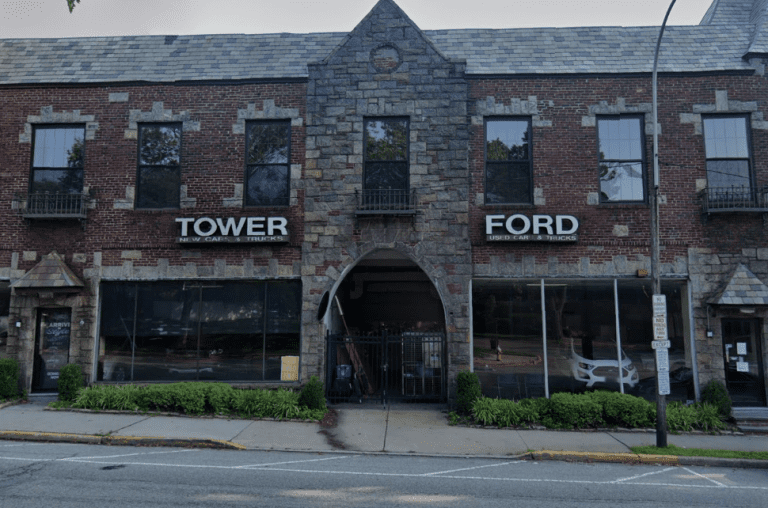
Residents from the Village of Thomaston and the Great Neck peninsula advocated for the former Belgrave Motors and Tower Ford building at 124 S. Middle Neck Road to be granted landmark status during a virtual meeting of the Thomaston Landmark Preservation Committee on Tuesday.
Presentations were made by peninsula residents, historical experts and the village’s hired consultant, Archeology Historic Resource Services, that showed how the building meets the village’s landmark qualifications. The state’s Department of Parks, Recreation and Historic Preservation declared the site eligible to be considered as a historic place on Oct. 29.
Jason Flatt of Archeology Historic Resource Services said the research his group carried out concluded that the building satisfies the village’s definition of a landmark and maintains a “very high degree of integrity.”
Anne Walker, an architectural historian and preservationist, spoke on the building’s Tudor Revival Style architecture that is similar to other structures throughout the Great Neck peninsula, of which some have been granted landmark status by the Village of Great Neck Plaza.
“Like the surrounding homes, the Tudor Revival style gave Belgrade Motors a layer of respectability and tradition, integrating this building into its context,” Walker said. “Not only is the integrity of the building intact, its continued use as an auto showroom since 1931 and its place in the context of Great Neck’s architectural tradition makes it exceptional.”
Nancy Solomon, Great Neck Plaza’s former preservation consultant, said the peninsula’s longstanding history with automobiles and repair shops down Middle Neck Road enhance the building’s historical prominence and it should be deemed a landmark.
“The Tower Ford building is really one of those pristine gems and reminders of the history of Thomaston and all the surrounding villages that are part of Great Neck,” she said. “The automobile centrality to the history of this is critical to understand and to recognize.”
Simeon Bankoff, a New York City preservation activist and the former executive director of the Historic Districts Council, a nonprofit organization, agreed that the building should be deemed a landmark, but cited the public’s strong support for wanting it to be declared a landmark as something the committee should take into perspective.
“This has become a true cause to live and something that the whole community has rallied around, which I think is wonderful and a very positive thing,” he said.
With more than 100 members of the public on the Zoom call, every resident who spoke was in favor of granting the building landmark status. The property has been a hot topic throughout the village after plans were submitted, and subsequently withdrawn, to develop a five-story apartment complex on the site of the building earlier this year.
In December, the village repealed a local zoning law that, along with the proposal, was met with strong opposition from the public. The law was passed during a July meeting and allowed the Board of Trustees to have “sole and unfettered discretion” on what conditions and incentive use permit may be granted to certain applicants. The law applied to applicants that have a property located partially in the Apartment B and Residence 10 zoning districts, a total area of at least 0.75 acres but not exceeding one acre, a depth at its greatest point of at least 200 feet and street frontage on Middle Neck Road of at least 230 feet.
The property at 124 S. Middle Neck Road, the former site of Tower Ford and the previously proposed apartment complex, lies partly in the Apartment B and Residence 10 zoning districts, has a total area of 0.96 acres, and has a depth of 234 feet, according to village documents.
The law, which remained in effect for 150 days after it was enacted in July, expired on Dec. 11, prior to the village’s repeal of it.
Stephen Limmer, the legal counsel for 124 Middle Neck Realty LLC, who put forward the plans to develop the five-story apartment, asked the committee on Tuesday to adjourn the matter for 120 days so that the applicant can “adequately make a presentation to protect its interests.”
Limmer said nothing would happen to the building or the plans in the interim and said his client understands the previously proposed building would not be met with a warm reception from the community.
“My client knows that the building that was proposed is never going to be approved and it has to be changed,” Limmer said. “And my client seeks to develop a proposed project that the village would approve and will be fitting.”
Residents asked the committee not to grant Limmer’s request for the 120-day delay, saying everyone in the village was aware of the Jan. 4 meeting date when it was scheduled in late November.
“The people love this building, and your client or whoever your client is, wants to tear down it and it will be vigorously opposed,” Thomaston resident Wendy Halpern said to Limmer. “This commission has been given tons of evidence showing why this building should be designated as a landmark.”
“It’s disingenuous for [Limmer] to come in here at the 11th hour in the middle of the hearing and request an adjournment,” Thomaston resident Nancy Sherman said.
The committee ultimately decided not to grant the adjournment. Chairman Donald Stern said the committee will draft a report and recommend whether the building should be given landmark status. That report and recommendation will then be given to the village’s Board of Trustees for potential adoption.






